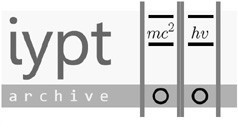
Statistics
There are some hidden, persistent regularities behind the apparently independent and randomly scattered numbers. Relying on multiple sources, this section provides an insight into the long-term IYPT trends and statistics.
Juror grades

The diagram shows the distribution parameters (population mean and standard deviation) for grades of individual jurors at the 23rd IYPT (2010.) The grades are averaged across all stages, performances, and PFs. The data clearly reveals that the individual grading standards vary among jurors, and result in a marked spectrum of average grades in the range from ca. 6 to ca. 8. The relative standard deviations, not shown here, vary in the range from ca. 0.1 to ca. 0.3. The marks above 8—9 and below 5—6 are statistically rare events.
Theoretical problems

It was quite typical at the early IYPTs to dig into problems about gold cubic planents, Grand Unification, or Asrtid Lindren’s Karlsson-on-the-Roof, where only a theoretical solution was expected. In some cases, the problems were formulated in a way that only limited empirical verification was possible as such. The annual number of theoretical problems, however, has been dropping sharply from ca. 10 in late 1980s, to only a few by late 1990s. Starting from 2003, each of the 17 problems was permitting a straightforward experimental investigation. (But not every solution, naturally, was using this opportunity.) The half-life of the theoretical IYPT problems can be estimated as 5 years, as the graph shows.
Stage regulations

In 1988, the IYPT was starting with only 5 min allocated for Report, 3 min allocated for Opposition, and 2 min allocated for Review. The duration of each stage performance, especially for the Report, was increasing stepwise until mid-1990s. It was, however, only in 2009 when the Reviewers were allowed to take floor for 4 min.
Growth over years

The graph depicts the growth of the IYPT in terms of participating nations and teams. Cumulant nations, or the total number of countries that have taken part at a IYPT, grows steadily with time at a mean rate of 1.5 new countries per year. The instant fluctuations of this rate are illustrated by the data for New nations, joining the particular IYPT for the first time ever; the decceleration trend (from expected 2.2 new countries in 1990 to expected 0.9 in 2010) is disputable given the limited statistics and is influenced by many new-born Eastern European nations in 1992—1993. The nations present at a particular IYPT increasingly lag behind the cumulant nations (with their mean growth rate of 1.0 per year.) The teams present at a particular IYPT usually outnumbered the present nations, until this was formally banned in 2008; the mean difference between them, as for 1989—2007, was 2.1, reminiscent of the policy that the host nation and Russia could be represented by two teams, and further teams might be permitted by LOCs.



